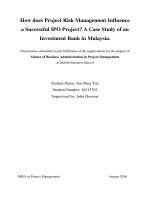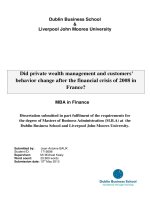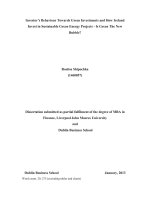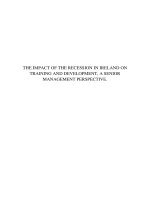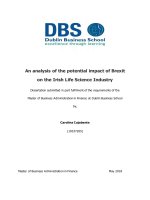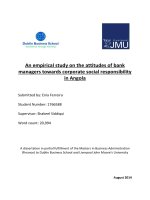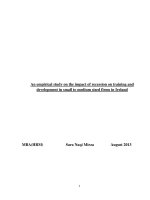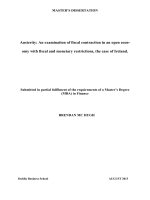Master Thesis in Economics: How the political instability has affected the Brazilian banking system in terms of student loans?
Bạn đang xem bản rút gọn của tài liệu. Xem và tải ngay bản đầy đủ của tài liệu tại đây (2.17 MB, 75 trang )
How the political instability has affected the
Brazilian banking system in terms of student loans?
Dissertation submitted in part fulfilment of the requirements
for the degree of
MBA in Finance
at Dublin Business School
Rodrigo Dultra
Student Number: 10352929
Supervisor: Enda Murphy
MBA Finance stream
2018
Declaration
I, Rodrigo Dultra, declare that this research is my original work and that it has never been presented
to any institution or university for the award of Degree or Diploma. In addition, I have referenced
correctly all literature and sources used in this work and this this work is fully compliant with the
Dublin Business School’s academic honesty policy.
Signed:
Date: 10/05/2018
2
Declaration
I, Rodrigo Dultra, declare that this research is my original work and that it has never been presented
to any institution or university for the award of Degree or Diploma. In addition, I have referenced
correctly all literature and sources used in this work and this this work is fully compliant with the
Dublin Business School’s academic honesty policy.
Signed:
Date: 10/05/2018
2
Abstract
Brazil is currently passing through a unique moment in its history. A mass corruption scheme has
been under investigation over the last three years and it has made many politicians be convicted and
go to jail. Accordingly, the former president Dilma Roussef suffered an impeachment and, differently
from the one that Fernando Collor suffered in 1994, this time there is a political instability affecting
not just the current economic conditions with entire industries suffering many jobs loss but also the
next political elections with the favourite candidate and former president of Brazil, Luiz Inacio Lula da
Silva, arrested. Accordingly, the economic situation is much worse and some industries have been
strongly affected. However, what has not been addressed yet is to what extent this political instability
has affected the student loans, an important aspect for to continuous development of the country.
As a result, this research aims to assess how the student loans have been affected by the political
instability in the country. Accordingly, primary data and second data were collected in order to run
the analysis on the theme. The first one was collected from interviews and questionnaires while the
second one from articles, books and academic articles to constitute the literature review. Moreover,
gaps were identified in the existing knowledge about the theme and were discussed and analysed.
In addition, it has been taken an interpretivism + positivism, inductive, survey, mixed-methods,
cross-sectional, qualitative + quantitative research design, which is explained in the research
merhodology chapter. Furthermore, this research contributes in the relation between political
instability and student loans by assessing the Brazilian situation at the moment.
4
Table of Contents
1. Introduction………………………………………………………………………………………………………………………..07
2. Literature Review .................................................................................................................... 12
2.1 Literature Introduction ....................................................................................................... 12
2.2 Banking system x economics and politics ............................................................................. 12
2.3 Banking loans x politics ...................................................................................................... 13
2.4 Brazilian banking system .................................................................................................... 14
2.5 Student loans .................................................................................................................... 15
2.6 Evolution of higher education funding ................................................................................. 17
2.5 Brazilian government policy for students - FIES ................................................................... 18
2.8 Student loan policy in the US .............................................................................................. 20
2.9 Literature Conclusion.......................................................................................................... 21
3. Methodology ........................................................................................................................... 23
3.1 Methodology Introduction ................................................................................................... 23
3.2 Research Design ................................................................................................................ 24
3.2.1 Research Philosophy .................................................................................................... 24
3.2.2 Research Approach ...................................................................................................... 25
3.2.3 Research Strategy........................................................................................................ 26
3.3 Research Choices ............................................................................................................... 28
3.4 Time horizon ..................................................................................................................... 29
3.5 Techniques and procedures ................................................................................................ 29
3.5.1 Data Collection ................................................................................................................ 29
3.5.2 Data Analysis .................................................................................................................. 30
3.3 Sampling - Selecting Respondents ....................................................................................... 30
3.6 Research Ethics ................................................................................................................. 31
3.7 Limitations of Methodology ................................................................................................. 32
4. Data Findings.......................................................................................................................... 33
4.1 Data from Interviews ......................................................................................................... 33
4.2 Data from Questionnaires ................................................................................................... 36
5. Discussion .............................................................................................................................. 39
6. Conclusions ............................................................................................................................ 43
7. Self reflection.......................................................................................................................... 45
7.1 Introduction ...................................................................................................................... 47
7.2 Kolb style .......................................................................................................................... 47
7.3 Honey and Mumford .......................................................................................................... 50
References ................................................................................................................................. 52
Appendices ................................................................................................................................ 58
5
List of Figures
Figure 1 – Brazil GDP from 2002 to 2016. Source: Nozaki, 2018 ……………….…………………………..……07
Figure 2 – Growth rates in the Construction Industry. Source: IBGE, 2017 …………………………………..08
Figure 3 – FIES. Source: FIES, 2018 …………………………………………………………………………………..……09
Figure 4 – Biggest Brazilian banks. Source: Central Bank, 2015 ………………………………………………....15
Figure 5 – Average earning earnings of college and high school graduate men. Source: Avery and
Turner, 2012…………………………………………………………………………………………………………………………..16
Figure 6 – Shift from grants to loans. Source: Congressional Researh Service, 2007 …………………….18
Figure 7 – Increase of the number of institutions and enrolments of tertiary education in Brazil from
1995 to 2014. Source: MEC 2016 …………………………………………………………………………………………….19
Figure 8 – Increase of universities price tuition in comparison to federal loans in the US from 2001 to
2012. Source: Lucca, Nadauld and Chen 2016 ……………………………………………………………………..…..21
Figure 9 – Research Onion. Source: Saunders, 2007 ………………………………………………………………....23
Figure 10 – Action Research process. Source: Saunders, 2007 ………………………………………………..….27
Figure 11 – Research choices. Source: Saunders, 2007…………………………………………………………….…28
Figure 12 – Research structure of this project. Source: own, 2018 ……………………………………………..32
Figure 1 Student loans per type in Brazil. Source: own, 2018 …………………………………………….……36
Figure 2 Students who managed to renew their visas. Source: own, 2018 ……………………………….36
Figure 3 Percentage of interest rate change. Source: own, 2018 …………………………………………….…37
Figure 4 Opinion of students on the political moment. Source: own, 2018 …………………………….……37
Figure 5 Connection between politics and loan changes according to students. Source: own, 2018.38
Figure 6 Kolb learning style. Source: Kolb, 1984 ………………………………………………………………..…..46
Figure 7 Honey and Mumford learning style. Source: Honey and Mumford, 1986 …………………..…49
6
1. Introduction
During the last few years, Brazil has been passing through several political scandals such as the Lava
Jato investigations with most of the politicians such as the president, senators and governors under
investigation as well as construction companies proven to be involved such as Odebrecth, OAS, and
Queiroz Galvao (Pamplona, 2017).
In the beginning of 2015, the former president Dilma Rouseff suffered an impeachment and Michel
Temer took over her position. However, he is also being investigated as well as most of the possible
candidates for the next presidential elections on September 2018, which increases the political
instability environment in the company. For instance, Geraldo Alckmin and Jair Bolsonaro are the
some of the main candidates according to media forecasts but both can be arrested even months
before the elections (GLOBO, 2017). Moreover, Luiz Inacio da Silva, Lula, the favourite candidate was
arrested in April 2018 after being convicted for corruption (O GLOBO, 2018).
In addition, due to the corruption investigation, some industries such as gas and petrol, retail and
meat have been progressively affected. For instance, the economy situation was worsened with
scandal in huge companies such as the public organisation Petrobras, which holds the monopolism of
petrol as well as the private meat provider Friboi, which was proved to fake the quality results of the
meat standards (GLOBO, 2017). As a result, the Brazilian economy has been strongly affected by the
political crisis with decrease on its GDP and consumerism as well as the growth of unemployment
rates. The graphics below illustrate how the Lava Jato operation, which started in 2014 has impacted
the economy in Brazil, specifically the GDP (Nozaki, 2018).
Figure 8 – Brazil GDP from 2002 to 2016. Source: Nozaki, 2018.
For instance, the gas and oil sector was responsible for roughly 13% of the GDP in Brazil and it was
expected an investment package of U$ 220 billion for the period between 2014 and 2018 just in
Petrobras. However, due to the Lava Jato operation, the sector was responsible for half of the GDP
decrease since 2014 and more than 20,000 suppliers were affected. Another example of an industry
7
impacted by the instability is the civil construction which, according to the graphic below, has
decreased up to 15% in comparison to past rates. Approximately 100,000 employees have lost their
jobs, which contributed to an increase in the sector unemployment rate of 72% in the period (Nozaki,
2018).
Figure 9 - Growth rates in Construction industry. Source: IBGE, 2017
Moreover, another important sector for the Brazilian economic development is the Student sector. In
general, there are more than 70 million students in Brazil currently, which approximately 10% is
represented by tertiary education. It is divided in public and private institutions with a huge price
difference between both which makes it necessary for many people to request student loans in order
to make it possible to finish their degrees (Investinbrazil, 2017). However, what it has not been
addressed yet is the effects of the political instability on the provision of these loans.
Furthermore, the address of the issue is not just important for the students but also to assess
whether such an important aspect of the economy has fluctuated during the crisis. According to
Zanuja Branco (2012), Brazil, India and China were part of the five economies that grew the most in
the last decade and they were also some of the nations that invested the most in tertiary education.
This is a very relevant aspect for the economy because it can improve historical issues that disturb
this country development such as unskilled labour and low production rates (Branco, 2012).
In addition, a student loan can be obtained in private and public banks. It presents simple repayment
methods, low interest rates and it covers all the living needs for the student such as rent and food.
The most popular and relevant student loan system in Brazil is run by the Fund of Student Financing
(FIES), a government body created in 1976 to select students in order to provide them loans for
private institutions and which has a budget of R$ 13 billion per year and 26% of the total current
students in university, which shows the relevancy and magnitude of the body. Its popularity is due to
8
a much lower rate, 3.4% per year, in comparison to private institutions that present a rate of roughly
7% and that it is the reason for the vast majority of student loans been obtained in the public sector
(MEC, 2017).
Figure 10: FIES. Source: FIES (2018).
Moreover, according to the OECD (2011), people who have tertiary education in Brazil earns 2.5 time
more than people who do not, which represents the biggest difference in a list of 30 countries of the
survey conducted by the organization. Accordingly, it also illustrates the social inequality presented in
the country and how important is for students to have a degree in Brazil (OECD, 2011).
Research question:
How
the
political
instability,
with
politicians
being
investigated
by
corruption
accusations, has affected the Brazilian banking system, in terms of student loans so far?
There is existing literature on important and related topics such as the relation between the banking
industry and the politics/economy of a country like the one written by Philipp Hartmann, the Brazilian
banking system with Geraldo Maia being one of the most popular authors on the topic; and banking
loans written by Paulo Sapienza. However, as explained with more details in the next section, none of
these researches have been addressed to what extent the Brazilian banking system has been affected
due to the political instability in terms of its student loans. They address their subjects in a more
general perspective and do not relate it to the Brazilian situation. Furthermore, the studies that are
about the Brazilian banking system are more descriptive rather than analytical and they do not
include the current political crisis nor the student loans as explained in another section further.
The reason for that is for being a much updated topic since the political instability only started in
February of 2015, it is the first time that such uncertainty has hit the country and for not having the
students angle in any research done so far. In this way, this paper would contribute to the literature
on the relationship between banking and politics with the example of the current Brazilian situation
9
with its student loans.
Accordingly, some sub-research questions have to be answered in order to assess it.
Questions for bankers:
How student loans have performed?
How student loans have been impacted by the political scandals?
Have student loans been diminished in terms of quantity since?
Has the student loan budget suffered any change since?
In order to know if the student loans have been suffered any effect or not from the political situation
it is going to be asked the two parts that are involved the most: bankers and students. The questions
will be answered through individual semi-structured interviews with the first ones and questionnaires
with the second from different backgrounds as explained in another section further.
Question for students:
Has your student loan suffered any change since the political instability started in
February 2015?
The hypothesis is that student loans suffered the effects of the political instability. In addition, the
variable that is intended to measure with this question is the student loan in order to compare the
two possible answers for it: yes or no. In this way, it would be able to get a sense if students are
suffering from the political instability or not.
As a result, this research will be extremely important for the public involved to be aware of the
current situation such as students who depend on loans to finish their degrees at university as well as
for bankers to assess its stability on the loans department under such negative macro conditions. The
aim is to provide a comprehensive review of what has happened so far with student loans during the
crisis, to assess to what extent they are susceptible to political uncertainty in Brazil and to provide a
useful data for banks to take into account for their strategy in the future. In addition, it can be useful
for any bank and government in a country that may present a similar situation in the future in terms
of stability in politics.
10
Aims:
Discover if banks have had changes in their student loan performance
Assess to which extent political instability and student loans are linked
Assess if student are having any issue regarding the obtaining and/or modification of
their loans
Provide a contribution to the literature on the relationship between politics and loans
Organisation of dissertation:
In chapter 1 is presented the introduction as well as the background, the aims, the sub research
questions, the justification and the contribution of the topic to the existing literature.
In chapter 2 is showed the literature review with relevant themes related to the topic of this study
and a summary for all in the end. It is explained why each topic is included and if there is
inconclusive evidences from the sources.
In chapter 3 is explained the research methodology carried out in this research. All the options of
every research methods are explained as well as the ones chosen. Every choice is justified why it is
the most appropriate one to the topic instead of the others.
In chapter 4 is presented and illustrated reasonably the findings of this research for both the
questionnaires and the interviews.
In chapter 5 is explained the review of this work, including the interpretation of the results, the
research question answer, the implications of the findings and the contribution of this research to the
area.
In chapter 6 is showed the conclusions from the analysis as well the summary of the findings and the
explanation of how they clarified the general issues raised on chapter 1.
11
2. Literature Review
According to Saunders (2007, p. 32), Literature review is a detailed overview of the relevant literature
regarding the topic of a dissertation. Accordingly, the main related themes to the topic are discussed
and critically evaluated below.
2.1 Literature Introduction
The aim of this chapter is to analyse academic existing themes which are relevant and related to the
topic of this proposal and to assess what is already known about the subject of this dissertation. In
addition, a better comprehension of what is already written by researchers will be used to support the
execution of the researched proposed .Firstly, it is going to be addressed banking system x economic
and politics to assess the relevant material about the relation between the sustainability of a banking
system and the political and economic situation of a country, to what extent they are linked. In this
way, it can provide a some insights of previous similar examples to assess if the political instability in
Brazil has affected its student loans. Secondly, banking loans x politics, to understand the effects of
politics on loans and, therefore, provide another benchmark for the dissertation.Thirdly, the Brazilian
banking system literature will be reviewed in order to obtain a greater understanding of how its
structure is and how it works.
Fourthly, the literature about student loans will be assessed since the theme of this project is about
the current situation of the ones in Brazil and it will provide a general knowledge. In sequence, the
evolution of higher education funding in order to understand the changes that have been happening
in the last decades in the world in order to provide a context on the evolution of the theme.
Furthermore, the literature on the Brazilian government policy for student, the FIES, will be analysed
in order to present a better comprehension of the subject since it is the student loan type that the
Brazilian governments provides for its students so that it is extremely important to understand it for
this project. At last, the student loan policy in the United States in order to provide another country
loan system to compare with the Brazilian one. It was chosen mainly academic journals that are
update as possible due to their quality and relevancy to the theme.
As a result, the analysis of the six themes above combined with the primary research will seek to
answer the research question of this dissertation.
2.2 Banking system x economics and politics
According to Hartmann, Straetmans and Vries (2005), the banking sector is an important aspect for
the stability of any economy of a country. Moreover, bank credit is proven to be an essential factor
for the financing of investment and economy growth in different types of economy. In addition, the
12
assessment of a banking system stability can be an essential interest of study for central banks and
supervisory authorities in order to preserve financial and monetary stability (Hartmann, Straetmans
and Vries, 2005). For instance, transparency and bank system risk issues demonstrated positive and
negative results on the economy in the US and European countries over the last decade.
Furthermore, Pradhan, Arvin and Nair (2017) demonstrated through the Granger causality test, a
statistical hypotheses test, which showed that in the long-term the banking sector has been strongly
linked to the economic growth in the G-20 countries. However, it is important to highlight that the
results differed from country to country depending on its development stage (Pradhan, Arvin and
Nair, 2017).
Furthermore, Stijn Claessens, Swati Ghosh, and Roxana Mihet (2013), analysed how macro-prudential
policies can limit bank vulnerabilities. According to them, policies need to be properly chosen,
calibrated and adjusted by country circumstances and the ones aimed at borrowers are moderately
effective in reducing banking risks and, consequently, crisis. For instance, Kenourgios and Samitas
(2007) associated the economic growth of Poland last decade to its finance sector by concluding that
credit to the private sector was of the main aspects of the long-term growth.
Another evidence of the strong link between politics and banks was shown recently by Houston et al.
(2014), demonstrating that the cost of bank loans is much lower for companies that have members of
its boards of directors linked somehow with politicians. It was possible to conclude it after the
analysis of a hand-collected data set of the political connection of 50 banks in the US from 2003 to
2008 (Houston et al, 2014). As a result, it shows that is not just the bank sector that influences the
economy and politics but also the other way round.
On the other hand, both studies focus more on avoiding politic and economic problems rather than
handling existing ones. In addition, there is no mention on the existing literature of student loans but
just general credit rates. For both reasons, these studies are not the same as this research proposes
including the Brazilian current situation and the student loans. However, it provides relevant insight of
how prudential policies tailored for a country can be beneficial for its situation, which can be useful
for this project since it primarily shows a certain relation between politics and banking system and,
therefore, would help to answer the research question.
2.3 Banking loans x politics
Paola Sapienza (2004) demonstrated how the behaviour of state-owned banks, when it comes to
lending, is affected by the election results of the party affiliated with a certain bank. For instance, the
interest increase or decrease depending on how strong is a political party in the area where a bank is
borrowing. Furthermore, there is also a strong relation between the interest rates of state-owned and
private banks on corporate loans for similar firms, showing that the government can interfere directly
13
according to its interests (Sapienza, 2004). In addition, according to Jimenez et al (2014), the amount
of granting loans can change quickly according to interest rates modifications. For instance, the
author showed that low capitalized banks can commit larger amount of loans with less requirements,
demonstrating how monetary policy affects bank loans.
In addition, the administration of loans for students is considered to be one of the most complicated
ones for banks since it is hard to ensure its payment (Hopper, 2015). Furthermore, Looney and
Yannelis (2015) stated that the cause number one for a decrease on student loans would be loan
defaults, which are mainly due to a weak educational background. Other issues such as income
verification, lack of commitment by the borrower and moral hazard are some of the most popular
problems in the US when it comes to student loans, which contrasts to the general idea that
monetary policies are the main one for student loan decrease (Lochner and Naranjo, 2016).
Moreover, Micco, Panizza and Yanez (2007), assessed the relationship between bank ownership and
bank performance, concluding that banks present different performances in developed countries and
the developing ones. Accordingly, they react differently to government policies, especially when it
comes to the provision of loans due to its interest rates (Micco, Panizza and Yanez, 2007)
In conclusion, it is a fact that bank loans can be affected directly by the government through its
monetary policy. However, it is not the only aspect that can disturb loans, especially when it comes to
the ones for students. As explained above, several causes have impacted student loans such as loan
default and income verification for instance in the US.
2.4 Brazilian banking system
According to Maia (1999), the banking restructuring in Brazil after the Plano Real, which was
implemented in 1994, is the biggest change in the Brazilian banking system in the last century and it
drove the industry after that. The new Brazilian banking structure presents public banks (both state
and federal), the entrance of foreign competitors and the private banks. This modification was
designed by the law number 4595, in 31 of December, called ‘The Banking Reform Law’. Moreover,
Barros and Wanke (2014) demonstrated how Brazilian banks have reacted differently to such big
changes like the Plano Real, which resulted in the end of the currency hyperinflation that was
presented in the country for more than a decade. Furthermore, most of the changes enhanced the
bank service provision in the country that became much more efficient for the public. However, the
supervision of the Central Bank of Brazil, which is linked to the Ministry of Finance, is still confusing
with plenty of bureaucracy (Barros and Wanke, 2014).
14
In addition, according to the evaluation of Pereira and Saito (2015), which was done by using
supervision data on credit rating and capital buffer of the Central Bank in Brazil, the author concluded
that the central bank play a major role in the market but its effectiveness is not satisfactory due to
complex rules, lack of transparency, inability to supervise and bureaucracy. Moreover, Tabak, Laiz
and Daniel Cajueiro, (2013) stated that the banking structure nowadays in Brazil is well established
with large, well-capitalized and liquid banks that are still reacting differently to the effects of
monetary policy measures in this country. Furthermore, there are five main banks, which run
approximately 70% of assets and loans based on the Central Bank data: Banco do Brasil, Itau,
Santander, Caixa and Bradesco. These biggest banks have branches all over the country but the
international operations are usually centralized its headquarters in Brasilia, Rio de Janeiro or Sao
Paulo. In addition, the impact of monetary policy is different across state-owned, foreign and private
domestic banks; which is proved by a number of evidences for that, including the bank balance
sheets. Moreover, according to the Moody evaluation, the Brazilian banking system is regarded as to
stable from negative (Tabak, Laiz and Cajueiro, 2013). However, the examples are more focused on
general activities such as assets and debts; rather than student loans.
Figure 11 Biggest Brazilian banks. Source: Central Bank, 2015
As a result, it is possible to conclude that despite the fact that the Brazilian banking structure is well
established, the banks do not present a homogeneous reaction across the 25 different states in the
country, to the monetary policies done by the Central bank, which is still inefficient when it comes to
supervise the market. A lot of progress has been made since the Plano Real in 1994 but there are still
some issues to be solved.
2.5 Student loans
According to Dowd and Cury (2006), student loans are a type of loan to support students in accessing
and finishing their post-secondary course. It also includes other costs such as tuition fee, books and
any other kind off supply for the study like the living costs. Currently, student loans are in operation
approximately seventy countries in the world and many of them can vary due to their own regulation
15
and laws (Dowd and Cury, 2006). Moreover they usually take advantage of government subsidies,
present lower interest rates and administrative costs and payment default risks. In addition, they can
be obtained in banks and specialized agencies; and the main difference between student loans and
scholarship is that the first one must be repaid (Shen and Zimerman, 2009). According to Avery and
Turner (2012), the total student loans amount has more than quadruplicated since 1990 due to the
importance that a degree can have on the financial life of people. In addition, the authors suggested
that enrolling in college is probably the best investment nowadays than some decades ago for young
people. For instance, the graphic below illustrates how the average earnings of a person with a
degree in his lifetime have become much higher than one that studied just until high school over the
last five decades in the United States.
Figure 12 Average earning earnings of college and high school graduate men in USA.
Source: Avery and Turner 2012.
On the other hand, negative results obtained during the degree can represent higher levels of
borrowing and, consequently, an increase in the odds of student default. This is the biggest risk and
concern for governments since its statistics has also increased over the last two decades (Avery and
Turner, 2012). Moreover, students that complete their degrees but are just able to reach the bottom
of wage distribution may present a salary that does not compensate the investment made. This is
considered one of the most important concerns for students before obtaining a loan. Accordingly,
Looney and Yannelis (2015) showed that the duration of the course is also related to the default since
16
Acknowledgement
I would like to express my gratitude to all the people who made this dissertation possible and who
have contributed to my entire academic development during my Masters in Business Administration
with emphasis in Finance at Dublin Business School in this last academic year.
Firstly, I would like also thank my entire family who has been encouraging and giving me all the
support all the time, allowing me to finish not just my first degree but also this postgraduate one.
They have always been proud of my achievements under every circumstances.
Secondly, I would like to thank my classmates that have worked and studied with me during all the
modules as well as all the lectures that assisted me patiently throughout the course.
Thirdly, thank to my supervisor Enda Murphy who has contributed with his support, motivation and
advices throughout my dissertation supervision.
Finally, thank to all my friends in Brazil and Ireland for the support and moments together.
3
Figure 13 Shift from grants to loans. Source: Congressional Researh Service, 2007.
For instance, the student loan policy launched in 1969 in Hong Kong is a case of success, starting
with small grants to cover expenses in 1969 to loans to cover everything for students to attend
universities in the United Kingdom.
On the other hand, according to a study made by Akers and Chingos (2014), through the collection of
data of the past two decades of the Survey of Consumer Finances (SCF) in America, there is not likely
to have a crisis on student loans despite the increase of both debt levels and tuition fees.
In conclusion, it is possible to see the evolution of student loan policies occurring in the world in the
last decades as well as positive examples such as Hong Kong and the United States. In addition, the
odd of not having a crisis in the USA despite price and debts increases. However, it is still not possible
to link to the Brazilian case and its crisis.
2.5 Brazilian government policy for students - FIES
According to Soares and Zanelatto (2016), the Financing Fund for Students (FIES) is a Brazilian
government policy that is democratizing access to higher education in Brazil. It grants student loans
for people who could not pass in public universities and cannot afford to study in a private college
(Soares and Zanelatto, 2016). In order to obtain it, the student has to meet some requirements such
as the maximum family revenue per month and a minimum score in high school (Aprile and Barone,
2009). Moreover, the program was created in 1999 offering an interest rate of 6.5% per year, which
was changed in 2010 to 3.5% per year. Furthermore, it represents an average of R$ 13 billion of
student lending per year, the average of total loan is R$ 220,000 (that is usually given to the student
on monthly transactions) and the duration of payment is related to the triple of the course duration (if
it is a 5-year degree, it can be paid in 15 years for example). However, under the FIES conditions,
either the loan is just granted for a year or for the entire course. If it is annual, the students have to
18
apply for a yearly renew until the end of the course. The average monthly payment is around 1,200
reais per year with law being the most popular degree with 94,000 new contracts in 2016 (Chaves
and Amaral, 2016).
In addition, Oliveira and Carnielli (2010) explained how FIES contributed to the expansion in higher
education in Brazil according to the opinion of several people involved in institutions. It increased the
odds for people from lower classes to stay in college and finish their degrees. As a result,
opportunities are more equal between poor and rich students. In addition, a considerable part of the
people involved in the study complaints that the program rules could be clearer, which causes a lot of
inappropriate critics by the press due to a misunderstanding of the program.
Moreover, Carvalho (2016) highlighted that human diversity and different socio-cultural realities were
the causes that lead the government to create the program. The aim was to provide social inclusion
as well as intellectual training opportunity for those who suffered from the historical inequality in the
country.
Accordingly, Vera Chaves and Nelson Amaral (2016) analysed the expansion on the educational policy
occurred in Brazil for higher education between 2003 and 2014. Through a quantitative analyse it
possible to conclude that it has contributed for financial gains by private institutions, increasing
significantly its number of students enrolled reaching 74% of the country. On the other hand,
institutions that provide research and extension were not equally helped financially. On the figure
below it is possible to see the evolution of the number of institutions and enrolments in private and
public universities over the last three Brazilian governments. The number of universities tripled and
the vast majority of new institutions founded are private, which showns the importance of the
acquisition of loan by students (Chaves and Amaral, 2016).
Figure 14 Increase of the number of institutions and enrolments of tertiary education in
Brazil from 1995 to 2014. Source: MEC 2016.
19
As a result, the studies have different focuses regarding the program itself in terms of its features,
expansion or social importance. However, they not take into account the current background with the
political issues as well as the policy immunity to them. On the other hand, they provide a great
understanding of the program and insights that can be helpful on answering the research question
while conduction the primary research.
2.8 Student loan policy in the US
According to Avery and Turner (2012), student loans in the US can be obtained through two different
forms: federal loans and private student loans. The first one is given by the federal government while
the second one is by institutions like Stafford and Perkins. Although federal loans are cheaper than
the private ones, they are still generating billions of profit for the government since their interest
amounts are higher than their costs. In addition, there are two types of federal loans: subsidized or
unsubsidized loans. The difference is that the interest of the first one is paid by the government and
it is required from the student to demonstrate financial need while in the second option, the interest
is paid by the student and there is no financial need requirement (Baum and Jhonson, 2015).
Furthermore, student loans represent nowadays $ 1.4 trillion spread by 43 million students that
receive in average an amount of $30,000 for the entire course. Moreover, student loans in the U.S. is
regulated by the Higher Education Act of 1965 but since there was a change made in 2005 on
bankruptcy laws, it is not common having losses with student loans since they are not allowed to be
discharged in bankruptcy (Simkovic, 2013). In addition, student loans are vital for the U.S. higher
education access since roughly 60% out of the 20 million people who attend college every year need
some kind of financial assistance for their studies.
On the other hand, a research made by Lucca, Nadauld and Chen (2016) suggests that the current
higher college costs are related to the increase of student loans in America. Accordingly, the graphic
below (see figure 5) shows that the number of student loans and the price of tuition fees have been
increasing simultaneously from 2001 to 2012.
20
Figure 15 Increase of universities price tuition in comparison to federal loans in the US
from 2001 to 2012. Source: Lucca, Nadauld and Chen 2016.
In addition, the graphic also shows that the financial crisis of 2008 did not strongly impact the
provision of student loans (Lucca, Nadauld and Chen, 2016).
Furthermore, a study made by Baum and Jhonson (2015), showed that national averages in the US
are not strongly reliable since it hides huge differences across the country. Each state has its own
rules, what causes a difference in the amount of loans provision.
As a result, the studies available on student loans in the United States of America cover relevant
aspects such as its structure and its increase over the last few decades, which is a relevant data to
compare with the Brazilian structure despite some huge differences, including the total due amount,
the number of loans and the fact that in the US the loans is just for the entire course. In addition, it
also stated that the financial crisis of 2008 did not impact the increase of student loans, which will
serve as a reference of the relation between crisis and student loans for this dissertation.
2.9 Literature Conclusion
The literature review above shows the existing and relevant material about banking system x
economics and politics, Brazilian banking system and banking loans x politics, student loans, Brazilian
student loan policy, evolution of tertiary education loans and student loans in the US. It is a
comprehensive material with different addresses and perspectives but there is still no focus showing
21
Abstract
Brazil is currently passing through a unique moment in its history. A mass corruption scheme has
been under investigation over the last three years and it has made many politicians be convicted and
go to jail. Accordingly, the former president Dilma Roussef suffered an impeachment and, differently
from the one that Fernando Collor suffered in 1994, this time there is a political instability affecting
not just the current economic conditions with entire industries suffering many jobs loss but also the
next political elections with the favourite candidate and former president of Brazil, Luiz Inacio Lula da
Silva, arrested. Accordingly, the economic situation is much worse and some industries have been
strongly affected. However, what has not been addressed yet is to what extent this political instability
has affected the student loans, an important aspect for to continuous development of the country.
As a result, this research aims to assess how the student loans have been affected by the political
instability in the country. Accordingly, primary data and second data were collected in order to run
the analysis on the theme. The first one was collected from interviews and questionnaires while the
second one from articles, books and academic articles to constitute the literature review. Moreover,
gaps were identified in the existing knowledge about the theme and were discussed and analysed.
In addition, it has been taken an interpretivism + positivism, inductive, survey, mixed-methods,
cross-sectional, qualitative + quantitative research design, which is explained in the research
merhodology chapter. Furthermore, this research contributes in the relation between political
instability and student loans by assessing the Brazilian situation at the moment.
4
3. Methodology
3.1 Methodology Introduction
In this chapter it will be explained with details how is going to be carried out the methodology of the
primary research for the research proposed. According to Kothari (2004), research mean a search for
knowledge and it can be defined as a scientific and systematic search for pertinent information on a
specific topic. Accordingly, Cameron and Price (2009) defined business research method is “a
systematic attempt at collecting and interpreting data and evidence in order to inform thinking,
decisions and actions in relation to an issue of interest to an organisation and its stakeholders”.
In addition, it will be followed the research onion (see figure below), which describes the layers of the
research process and it demonstrates how is going to be the research design including its philosophy,
approach and strategy; the sampling, data collection, data analysis, ethics issues that may arise as
well as the limitations of the methodology. It starts from the macro to the micro with the outer layers
focus on thinking about research philosophies and approaches, the central ones reflect the need of
research strategies and choices adoption; while in the centre there are the data collection and
analysis as the main concern. It illustrates progressively all the stages that will be covered in order to
develop the research strategy (Saunders, 2007).
Figure 16 Research Onion. Source: Sanders, 2007.
23
3.2 Research Design
3.2.1 Research Philosophy
According to Saunders, Lewis and Thornhill (2007, p. 104), a research philosophy is an “overall term
that relates to the development of knowledge and the nature of that knowledge in relation to
research”. In addition, it also considers the ways in which data should be collected, analysed and
used. Furthermore, it contains some of the personal assumption of this author and how he views the
world and there is no philosophy better than another, just the most suitable for each case. Moreover,
the main strands of research philosophy are positivism, interpretivism and realism.
Firstly, Positivism is the research philosophy that adopts highly structured methods to facilitate the
replication, which results in law-like generalisations. It derives from natural science and it presumes
that the social world exists objectively and externally. In addition, it focuses on facts and it considers
knowledge valid only if it is based on experience and observations of the external reality. Moreover, it
uses quantitative methods such as surveys, experiments and statistical analysis. As a result, it usually
lends to predictable results (Saunders, 2007).
Secondly, Interpretivism is the research philosophy that focuses on the comprehension of different
human behaviours in their roles as social actors. In another words, it is the opposite of positivism
since knowledge is constantly reconstructed through different experiences, what leads to many
different possibilities of interpretations. Moreover, it considers different realities based on the
different points of view of the people involved so that the knowledge must be interpreted in the
context of the researcher academic experience. Furthermore, it is inductive and theory building. As a
result, it focuses on understanding the interpretations and meanings of social actors in order to
understand their perspective, what makes this philosophy a very contextual one (Hatch and Cunliffe,
2006).
Thirdly, Realism is a research philosophy that stresses that objects exist independently of our
knowledge of their existence. It is originated from critiques of positivism and interpretivism, which are
considered too deterministic and too contextual respectively. Accordingly, it claims that real structure
exists and it is independent of human consciousness and that knowledge is socially created. Although
it is a different philosophy, it presents some similarities with the other two. For instance, realism is in
accordance to interpretivist positions in the sense that it considers natural and social science are
different, and that social reality is pre-interpreted. On the other hand, it is in line with positivist
thinking in the sense that it also follows the idea that science has to be empirically-based, rational
and objective (Cameron and Price, 2009).
24
As a result, the philosophy adopted in this study is going to be a mix of interpretivism and
positivism. The first one because it recognises that business people are different and interpret
business situations differently; is very contextual so that it will take into consideration the Brazilian
situation at the moment, which is very particular and there is no previous similar example in the
world as showed in the literature review. In addition it is perfectly suitable for the topic because
different banks could have had a different reaction to the instability, which will be examined on the
interviews. Moreover, the positivism will be utilized for the quantitative data collected and it suits the
topic because it will be concerned with the facts on the student questionnaires results that will
confirm whether their student loans were affected by the crisis or not. Furthermore, Realism was not
chosen since it is a philosophy that requires an understanding of the deeper structures and relations
which are not easily observable, which would be extremely time consuming for this study and,
therefore, inappropriate for this dissertation (Saunders, Lewis and Thornhill, 2007).
3.2.2 Research Approach
Following the research onion, the second step is identifying the most suitable research approach. In
order to do so, two different approaches are explained below: the deductive and the inductive
approach.
Firstly, a deductive approach is the one that involves the testing of a theoretical proposition by
adopting a research strategy in order to test it. Accordingly, there are five steps in a deductive
research, which are: defining research questions from the existing theory, operationalizing them,
looking for its answers, analysing if the results are in accordance to the theory or if it needs a
modification; and confirming the initial theory or modifying it. It aims to test a theory, it is usually
associated with the positivist philosophy and the conclusion follows the premises (Saunders, Lewis
and Thornhill, 2007).
Secondly, an inductive approach is the one that regards the development of a theory as a result of
analysing data already collected. It aims to generate a new theory based on the data collected and
observations done by the researcher. It starts with research questions, it is usually associated to
qualitative data and it is concerned with the context with the events. In contrast to the deductive
approach, the conclusion not always follow the premises and it is not necessarily true (Cameron and
Price, 2009).
As a result, the approach chosen for this research is going to be inductive since there is no specific
theory to assess how the new political instability has affected the student loans in Brazil. In addition,
it suits the topic since it started with a research question and the result will be generated from the
analysis of the data collected. Moreover, only after the completion of the analysis of the data is that
the research question output will be produced. Furthermore, due to the nature of the approach, a
25

